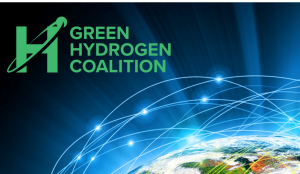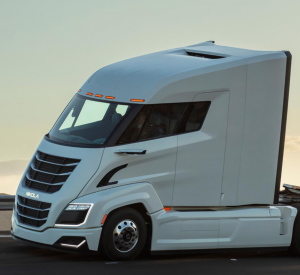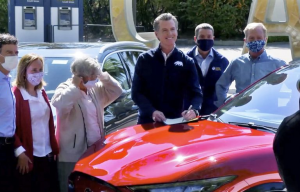October 1, 2020 – Volume 22, Issue 5
In This Issue
- Flanigan’s EcoLogic: Hiking Aspen’s Lost Man Loop
- A Green Hydrogen Future?
- Residential Fuel Cells for Energy Resilience
- General Electric’s Green Pivot
- Walmart’s Regneration
- California To Ban Gas-Powered Cars
- Mandragore
- China’s Carbon Neutrality Commitment

Flanigan’s EcoLogic: Hiking Aspen’s Lost Man Loop
September 21, 2020, Aspen, Colorado: Gorgeous fall day, the aspen leaves turning yellow and orange, painting great swaths of shimmering gold on the mountainsides, accenting rockslides and meadows. Hillsides carpeted in reds and oranges and browns, enchanted.

Not sure why the drive up Independence Pass the other day made me queasy. It is scary, but I’ve been up and down that incredible road perhaps a hundred times. I’ve biked to the summit a half dozen times. Heading up, out of Aspen, there are dangerously steep drop-offs to the right. It’s a narrow, winding road, with traffic coming at yah. Yikes. Some guy with a trailer. Every year a car or two topples off this harrowing road. This year a lucky lady lived after her car tumbled 500 feet down the cliff.
Made it… to the lower trailhead for Lost Man Loop that is. We drop my rental and I jump into my brother’s new Bolt, and we proceed to the upper trailhead passing the ghost town of Independence. Hard to imagine living and mining there. Such altitude, exposed mountain slopes, avalanches of rocks and ice. The trail takes off from the final switchback, just before the road towers to the summit, arcing in a 6% grade trajectory to Independence Pass at 12,095 and the Continental Divide.
Out of shape? No. Acclimated? Not that either. There’s thin air up here. We begin to hike at 11,506 feet. We’re above tree line; the trail follows a small, gurgling stream. The rocks are covered with lichen. The higher we get, the more pervasive the rocks are. No wonder they call these the Rockies! That makes the trail a bit treacherous. You want to take in all the views, but gotta keep your eyes on the rocks. We pass the little lake… so peaceful, perched so high in the Rockies.

A marmot pops up to check us out. For me it’s tough going… nearly two hours of steady incline to Lost Man Pass at 12,810 feet. As we crest an incline, it’s a Sound of Music moment… the hills are alive. The magnificence of the Rockies is omnipresent. Just to the East is Mount Elbert, Colorado’s highest fourteener at 14,439 feet. This is massive geology. We can see for miles; humbled by the scale of these mountains.

There’s snow on the way down to Lost Man Lake, the remnants from a freak early winter storm a few weeks before. Colorado had an unprecedented 60-degree temperature swing, from the heat of summer to snow. We slip and slide a bit on the mushy snow on the trail. I make a snowball and throw it. At the lake we take basic lunch, apples, PBJ, carrots, and granola bars.
For the next hours we’re on a steady decline. The Lost Man Loop trail meanders, following the valley floor. We pass willows thirsting on streams. The wind whips through the valley. We traverse hillsides, rounding our way downstream. It’s a massive and enchanted valley completely devoid of human civilization. This is a cathedral. We’re breathing in the splendor of the mountains. We’re struck by the patterns in the carpet of grasses made by streams.

As we get lower the ecosystem and its flora changes. We walk through evergreen forests; the stream is now bigger. My legs are tired, I’m stumbling a bit. A work-out; a fulfilling trek… a bit unending. Then finally, there is it, the telltale reservoir that lets us know that we are getting back to civilization… a welcome parking area on a narrow road ten miles up Independence Pass.

Six days later, and somewhat more acclimated, I hike the Maroon-Snowmass Trail to Snowmass Lake with my life-long friend Robert Sardinsky (Sardo), as well as daughters Sierra and Skye. It’s an 8.5-mile uphill trek from trailhead in Old Snowmass through aspen groves shimmering in the morning light, open meadows, pine forests, traversing rockslides. After five hours we make it! Snowmass Lake is picture post-card perfect, a broad expanse of clear cold water shimmering, surrounded by fourteeners, topped off with billowing clouds and fantastically clear blue skies above. We take lots of pictures and breathe in the grandeur and intense beauty of it all. The 17-mile roundtrip leaves us wobbly that evening, inspired and yes, a bit beaten up.

Quote of the Week
“Green hydrogen
may well be the new strategic fuel for our generation.”Dr. Laura Nelson, Vice President
Strategen
A Green Hydrogen Future?
A webinar put on by Strategen made clear the huge role that green hydrogen may have in our future. While the “lithium-ion revolution” and batteries have stolen the front pages of the sustainability movement, there is a clear and powerful voice advocating the use of hydrogen… what the moderator, Dr. Laura Nelson from Strategen called the ultimate game changer, and later “the new strategic fuel for our generation.”

Leading the charge is the Green Hydrogen Coalition, www.ghcoalition.org. It has recently published “The Green Hydrogen Guidebook” which can be downloaded for free. It addresses the production of hydrogen, its distribution, safety, and policy challenges. While there are many issues to address, the Coalition makes clear that hydrogen, and notably green hydrogen sourced from renewables, can play a very important, large, and positive role in our energy future. It works for cars, trucks, for trains, for planes, for buildings, and factories.
The webinar was supported by a number of firms including Southern California Gas, BloomEnergy, and MCE Energy. It presented a view of the breadth of applications, across sectors, from aviation, to trucking, to mining, putting the value of hydrogen in a new light for me.
“Air, Land, and Earth: Multi-Sectoral Decarbonization” began with the use of green hydrogen for aviation. Brilliant was the presenter, a Russian born and educated and acclaimed scientist by the name of Dr. Val Miftakov. He is now at the helm of a company called ZeroAvia… making electric planes that use hydrogen fuel. His primary point is that aviation is a segment that can use green hydrogen most, and which will accelerate the adoption of green hydrogen for all sectors… from mobility on land, to heating and cooling buildings, and powering industries.

Photo Credit: ZeroAvia
Miftakov mentioned Greta Thunberg and her strong resistance to flying, rightly so as its emissions are huge, and growing. India and China and other developing countries are lapping up aviation for business and pleasure. This is having a very significant greenhouse gas impact in the wrong direction. Miftakov mentioned that if you take a few international flights a year, aviation will dominate your footprint. Keeping aloft is inherently energy intensive. British Prime Minister Boris Johnson wants “to make flying guilt-free” by electrifying transport.
Miftakov presented the options for greening aviation: Batteries and electric propulsion are being tested, but fundamentally he noted, batteries are too heavy, 50 times as heavy as conventional jet fuel for the same range. Biofuels are another “solution” for aviation but are dismissed as this fuel source is fundamentally unscalable to meet aviation needs. Synthetic fuels are non-economical, and still stuck with non-CO2 greenhouse gas emissions. An option is conventional jet engines using combusted hydrogen… a scenario in which hydrogen is burned. This “solution” requires large volumes since hydrogen fuel is 10 times less dense than jet fuel.
What Miftakov favors and believes is suitable and scalable for the entire aviation industry, is the use of green hydrogen powering fuel cells and an electric power train. Fuel cells – through which electricity is produced through a chemical process — deliver much higher efficiency than combustion turbines. Thus this solution promises longer range, lower costs, and zero emissions. And it’s catching on. Airbus is retooling its Airbus 320 for hydrogen, reworking its product line for use of liquid hydrogen tanks in the wings, fuel cells coupled with each engine.

Photo Credit: Nikola
Next up, trucks. Trucking and transport have been a dominant source of greenhouse gas emissions. Since 2016, transportation has been the dominant U.S. source. Trucking requires rapid fueling and that can be accomplished with hydrogen. Note that both battery-based and hydrogen fuel cell-based vehicles use electric drive trains. Elizabeth Fretheim presented on behalf Nikola Motor Company, in the news that very week for deceptive claims about its technology. This she did not discuss. Instead she presented valuable perspectives on the revolution that electric trucks represent as there’s no time for an evolutionary approach.
Nikola is building electric trucks, hydrogen fueling stations, and off-road vehicles for military and recreation. It’s building a consumer pickup truck with General Motors with “power export capability,” meaning that it can plug in to another EV or even facility and provide power. It’s building refuse trucks, a “perfect application” for electric mobility given these trucks’ stops and starts. Class A freight trucks can be either battery-electric or hydrogen fuel cell electric. Range is the differentiator. Batteries have a 150 – 300 mile range; fuel cell trucks can achieve a 500-mile range. Hydrogen provides for a lighter technology and quicker fueling time. Fretheim discussed the development of and need for alternative fuel corridors for trucking and the need for policy changes to shift subsidies from fossil fuels to electrification. She discussed the proposed European Hydrogen Highway system.
The final presenter discussed a niche application for green hydrogen, namely the mining industry. Fast forward: Yes, soon there will be green diamonds… mined with 100% green energy. Michel Carreau works for Hatch, a consulting engineering and project implementation firm. Large mining operators have made major commitments to sustainability and zero emissions. That means no use of diesel or other fossil fuels for trucks, machinery, and operations. Carreau’s job is to turn that commitment into functional operations.

Photo Credit: Hatch
The Raglan nickel mining complex in northern Quebec is off the grid, with 6 MW of wind, 3 MW of batteries, and a hydrogen fuel cell system. It looks really cold there, just south of Deception Bay. Carreau shows pictures of mining equipment including a massive 300-ton truck that can refill its hydrogen fuel tank in 10 minutes. He shows pictures of machines that crush ore. At Raglan, hydrogen is used for heating, process energy, for fuel, and to generate electricity.
During the Q&A, the safety of hydrogen was raised. So many of us have a perception of the dangers of hydrogen. But this was summarily dismissed. The presenters stated that the use of hydrogen has been proven to be safe, that there are already 100 million tons of hydrogen produced each year. It is a known process; there are engineering standards in place to ensure safety.
What’s really happening now, what we learn, is that hydrogen is being applied in new use cases… in vehicles, planes, buildings, and industries including mining. Beyond these new applications are commitments to green hydrogen that is by definition, emissions free. There is momentum in the green hydrogen space. The use of hydrogen is accelerating in multi-sector applications. Thanks Strategen. Stay tuned.
Residential Fuel Cells for Energy Resilience

Image Courtesy of SOLIDpower
Microgrid News is a good read for those who a) recognize that the grid is less and less stable due to climate change, and b) who are committed to finding resiliency solutions that are carbon-free, financeable, and scalable. Microgrid News reports that the massive fires in the West are causing smoke that is blocking out the sun to generate photovoltaic energy. Smoke and solar don’t mix. Now consumers are adding to their solar + storage systems, with solar + storage + fuel cells.
Instant On is a residential microgrid developer. The smoke from California wildfires is blocking up to 95% of production of the microgrid systems that it has installed in the Bay Area. In one case a solar system that would normally be generating 40 kWh a day, only produced 1.25 kWh. Making the case for residential fuel cells, Instant On’s CEO notes that “Fuel cells can power a house 24/7 and take less time to install than a solar microgrid.”
Now Instant On is working with homeowners to install BlueGEN fuels cells in homes to serve as backup in these instances. The company plans to use fuel cells in three veteran communities comprising nearly 4,000 homes that each will have a microgrid. The pilot envisioned involves 5 kW solar, 40 kWh battery storage, an advanced home energy management system to isolate critical loads, and a 1.5 kW fuel cell for each home. BlueGEN was recently approved by Public Service Electric and Gas for installation on Long Island, New York. While subject to local jurisdiction, from a utility standpoint, the fuel cell are treated like a gas appliance. They may be problematic, however, in a growing number of California cities which have banned natural gas in new construction.
BlueGEN is a microCHP (combined heat and power) system with a track record in the United Kingdom and other European countries. Designed for homes, small businesses, and public buildings, each washing-machine-sized unit supplies 13,000 kWh per year. Thus a single fuel cell can meet a home’s electricity needs in whole or in part depending on usage. It boasts production of power at 50% of the cost of conventional sources and 60% system efficiency using natural gas or biomethane.
The fuel cells also generate heat which can be used by tying into a home’s domestic hot water heating system. BlueGEN boasts environmental benefits, 240 grams of greenhouse gas emissions per kWh versus German power plant mix 550 g/kWh. Other selling points are ease of installation, standard connections, and compact size.
BlueGEN’s energy resilience technology is based on the SOLIDpower group’s solid oxide fuel cell. SOLIDpower is in the high-temperature fuel cell space, developing, manufacturing, and marketing fuel cell systems in Italy, Germany, Switzerland, and Australia. With BlueGEN, the company offers micro-CHP systems. Closer to home, Watt is based in Pennsylvania and makes a 1 kW SOFC fuel cell. Panasonic is adding a fuel cell especially designed for condos to its line of Ene-Farm residential fuel cells.
General Electric’s Green Pivot

General Electric announced on September 21st that it will no longer build coal-fired power plants. GE Senior Vice President Russell Stokes noted that, “With the continued transformation of GE, we are focused on power generation businesses that have attractive economics and a growth trajectory.”
Good timing, a day after announcing that it would get out of the coal power business, GE announced that it has been chosen to supply turbines for what will be the world’s largest offshore wind farm. The Dogger Bank A & B wind farm will use 190 Haliade-X13, 13 MW turbines. The wind farm’s first two phases will have a capacity of 2.4 GW. This is the first use of the Haliade-X13… a massive machine. GE notes that one spin of its blades can generate enough electricity to power a UK household for more than two days.
Walmart’s Regeneration

Zero net is a buzzword term in the energy and environmental worlds. The goal is to cut carbon, to cut waste, and to promote clean and healthy communities. Regeneration takes it a step further. It inherently recognizes that things need to be fixed… our air, forests, oceans, rivers, lakes, … in fact many ecosystems need to be restored after being taxed and abused. We need to actively clean our communities, our waterways, our air. Companies need to rethink the way they do business, and in cases their businesses.
To be sustainable, it’s not just about zeroing out our current impact, but instead, it’s about regenerating healthy ecosystems. And in this regard, a new Walmart announcement puts it in the spotlight: With 11,500 stores in 27 countries and fiscal year revenues of $524 billion in 2020, this gorilla retailer is leading corporate America in its commitments and directions.
Some of the commitment headlines: Walmart is committed to zero emissions by 2040. It is committed to restoring 50 million acres of land and 1 million square miles of ocean by 2030. It’s the corporate commitment to leadership that is perhaps most exciting: “We want to play an important role in transforming the world’s supply chains to be regenerative.” The company is looking beyond decarbonizing its global operations. It is on a path to be regenerative… “one that works to restore, renew, and replenish… and encourages others to do the same.”

“Our vision at Walmart is to help transform food and product supply chains to be regenerative, working in harmony with nature to protect, restore and sustainably use our natural resources.” Walmart, based in Bentonville, Arkansas, now claims 15 years of sustainability leadership “to help combat the cascading loss of nature threatening the planet.” It has a commitment to 100% renewable power by 2035 with wind, solar, other renewables; electrifying all vehicles, including long-haul trucks by 2040; using nothing but low-impact refrigerants; and electrification for heating in stores, clubs, data and distribution centers by 2040.
The regenerative efforts are impressive: Walmart will continue its efforts to preserve at least one acre of natural habitat for every acre of land developed by the company in the United States. It is driving adoption of regenerative agricultural practices, sustainable fisheries, and forest protection and restoration. It is investing in and working with suppliers to source from place-based efforts that help preserve natural ecosystems and improve livelihoods.
To date, Walmart powers 29% of its operations with renewable energy and diverts 80% of its wastes from landfills and incineration globally. It is also working with its suppliers. The Gigaton Project’s goal is to avoid a gigaton of GHGs by 2030. So far, more than 2,300 suppliers have signed on. Since 2017 and in aggregate, they have registered 230 million metric tons of avoided emissions.
California To Ban Gas-Powered Cars

Image Courtesy of CarAndDriver
The Executive Order makes sense as the State of California is on fire. Further, transportation accounts for 50% of all greenhouse gas emissions in California. A clear indication of climate change, the ominous fires are threatening our health and livelihoods. Nearly every Californian breathing bad air, a very sharp and personally invasive reminder of nature’s fury.
California Governor Gavin Newsom’s Executive Order curbs the sale of new gasoline and diesel-powered automobiles and passenger trucks by 2035. That target is anticipated to achieve more than a 35% reduction in GHGs and an 80% improvement in nitrous oxide emissions. Concurrently, the California Air Resources Board (CARB) will develop regulations for medium and heavy-duty vehicles to be emissions free by 2045, 2035 for drayage trucks (defined as shipping goods short distances, eg from port to rail terminal). Newsom noted that, “Cars shouldn’t melt glaciers or raise sea levels threatening our cherished beaches and coastlines.”
Mandragore
A Parisian design firm, rescubika, has designed and proposed a massive, 2,400-foot building for New York City that will trap carbon emissions in the atmosphere. That’s taller than Freedom Tower at One World Trade Center at 1,776 feet. The building was conceived in response to New York City’s “City of Tomorrow” project that aims to make the city carbon neutral by 2050. The project’s design was inspired by the mandrake plant.

Image Courtesy of Rescubika Creations
The proposed structure would be built on Roosevelt Island in the East River and is designed as “the world’s tallest carbon sink,” absorbing more greenhouse gas emissions that it emits. Mandragore would have over 160 floors, 36 wind turbines, 1,600 trees, 264,000 square feet of plant walls, a geothermal system for heating and cooling, and 75,000 square feet of solar panels. Each apartment includes a home office to reduce commuting. Mandragore would be largely built with wooden materials.
China’s Carbon Neutrality Commitment

Image Courtesy of CGTN
On September 22, at the United Nations General Assembly, China’s President Xi Jinping announced the country’s goal to achieve carbon neutrality before 2060. By itself, it could lower the projected global temperature by the year 2100 as much as 0.2 – 0.3 degrees C.
Currently China accounts for nearly half of global coal demand. It continues building coal-fired power plants. But Bloomberg Energy News reports that, “this era is quickly coming to an end….”
China’s announcement is likely good politics and well as good policy. Unlike America that is an oil and gas net exporter, China is a net importer. In recent years, China has become the global powerhouse in the renewable space. China now produces two-thirds of the world’s solar panels and lithium-ion batteries, and 45% of all wind turbines. Experts believe the top-down nature of China’s government structure, and policies developed by the National Development and Reform Commission, bodes well for implementing aggressive climate targets.

China’s commitment to carbon neutrality will indeed be a game changer if its policy is realized with action. The country’s commitment follows a 2015 commitment to peak its emissions by 2030. Analysts believe this peak may actually occur in the next five years and ahead of schedule given China’s rapid urbanization and the fact that cities are far less GHG intensive than rural areas.
